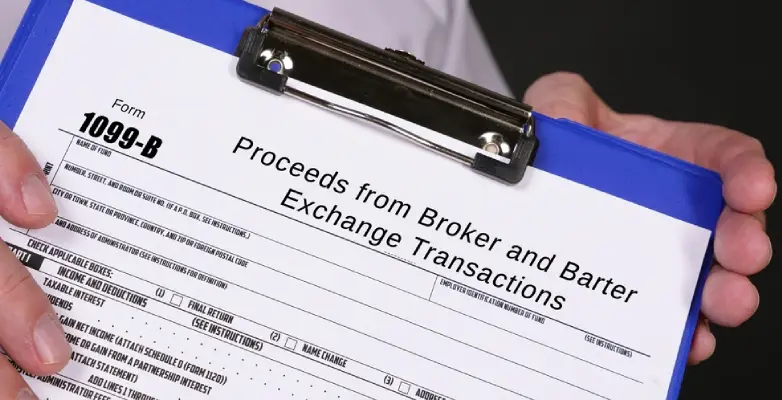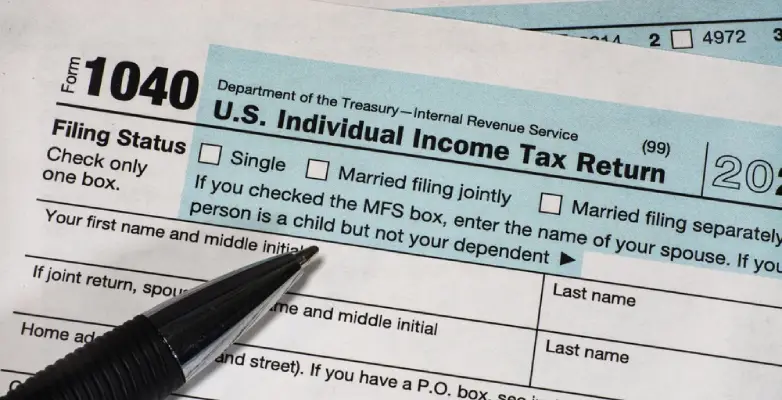Brokerages and barter exchanges are the two terms which are used for Form 1099-B. It is an Internal Revenue Service (IRS) tax form which is used to record customers’ earnings and losses over the course of a tax year. All the Individual tax payers always receive the already-completed form from their brokers or barter exchange.
We can manage capital gain taxes much easier with the help of Form 1099-B. Capital gain is a profit which you receive from the selling of an item for the need of more money than the cost you had buy it earlier.
In order to determine their preliminary earnings and losses, tax payers move the data from 1099-B to Form 8949. In this form the Schedule D of their tax return, the outcome is recorded.
You should expect the receiving of one or more copies of Form 1099-B in January in case if you sold any of the stocks, bonds, derivatives, or other securities of yours through a broker. Profits or losses from these trades in the previous year are reported with the help of these forms. Those who take part in official bartering for the sailing of these networks, they may also obtain one copy of the form.
Table of Content
- 1 Details about the Form-1099 B
- 2 Broker or Barter Exchange May File Form 1099-B
- 3 How can You Use Form 1099-B:
- 4 Detail of the Short-Term or Long Term Gains
- 5 The Capital Gain
- 6 Who Can File Form 1099:
- 7 Filing of Form-1099 B:
- 8 Downloading of Form 1099-B
- 9 Entering of Form 1099-B
- 10 The Barter Exchanges
- 11 Frequently Asked Questions
Details about the Form-1099 B
Some of the times, 1099-B Form typically provides you the details about the securities or property which are involved in a transaction that are handled by a broker. The Stockbrokers are the one who are known as a broker since they use to mediate the transactions between the buyers and the sellers on the behalf of their employer or the company in which they use to work for.
A broker is a person who arranges all the deals between the buyers, sellers, or traders. For example – Imagine a broker as an intermediary who guarantees that the transaction will go as planned about which each party receives the information which they need. Brokers used to work in the variety of fields including commerce, Real Estate, insurance, and finance.
Basic Principles of Form-1099 B:
Here are some fundamental guidelines which everyone has to follow for filing the Form 1099 are:
- Brokers used to send Form-1099 B to their clients so that they can file taxes.
- There is a form lists which explain about each and every transaction that was done throughout the tax year.
- People use this data to complete their Schedule D, Which help them in listing their gains and losses for the tax year.
- The total of the gains and losses explain detail about the person’s taxable gain or loss for the entire year.
- In case if sales of any of the securities occurred in a single transaction, then the brokerage firms and the one who involved in bartering operations are required to submit their separate forms.
Form-1099 B Includes:
Following are the list of some things which are included in the Form 1099, they are:
- The brief summary of the entire items which are sold, for example- Hundred of the shares of XYZ Co.
- The detail about on which Day, Date and Time you have purchased or obtained it.
- The detail about on which Day, Date and Time you have Sold it
- The detail and exact amount that how much did you paid for it.
- The detail and exact amount that how much you received for it when you sold it.
- Whether your broker withheld any of the federal tax, if yes describe it also.
Basic Principal to read Form-1099 B:
Form 1099-B explains about the issuers that provides yours information as well as their own information. The description of the sold property, the date of acquisition, the date and price of sale, the purchase price, and any applicable deductions are also included in this. Gains or losses which are realized, any of the federal taxes withheld, and state tax withholdings are further pieces of information which are included in this.
Broker or Barter Exchange May File Form 1099-B
Some of the individuals for whom a broker or barter exchange may file Form 1099 are listed below:
- The Broker can file Form-1099 to the person for whom they use to exchange cash for the sale of stocks, commodities, regulated futures contracts, forward contracts, debt instruments, options, securities futures contracts, etc.
- The Broker can file Form-1099 against the person who transferred goods or services with the help of a barter exchange, or from Whom the cash is received, stock, or other property from a firm that the broker knows or has a cause to know that he had its stock purchased in an acquisition of control or had a detail of significant change in the capital structure of reportable on Form 8806.
How can You Use Form 1099-B:
The ability of a person to handle all the capital gains and losses which are on the tax return of yours is aided by the Form 1099-B. You can typically define profit as a capital gain and it may be taxable in case if you are trying to sell something for the amount which is more than the amount you paid for it earlier. Contrarily, in case if you are trying to sell something for the amount less than the amount you purchased it earlier then you may have a capital loss. Whenever you have capital loss then in that case you may be able to use the lower taxable capital gains or other income of yours.
- The Capital gains taxes are normally paid by using Schedule D together with your income tax return.
- In case if it is necessary to fill the Schedule D and Form 8949 then it can be filled out by using the information from Form 1099-B which is already filled.
Detail of the Short-Term or Long Term Gains
Whether the gain or the loss which is involved is short-term or long-term is indicated in Second box of the form.
- In most of the circumstances, any of the gain or loss from a transaction is temporary but it is only possible if you possessed an asset, like a shares, for a year or fewer before selling it.
- Normally, if you owned an asset more than a year, you would have a long-term gain.
- The distinction between the two is crucial because long-term gain tax rates can be much lower than short-term gain tax rates.
Some of the brokerage firms used to issue a “Composite 1099 Form” in place of many different 1099 forms, Which includes the 1099-B, 1099-INT, and 1099-DIV etc.
The check boxes which are available for short-term and long-term transactions on the standard 1099-B form are just one of the examples of information which is occasionally missing from the part of the individual in case of the composite forms. The key work of the composite form is only to aggregate the various types of transaction so that you can quickly distinguish between short-term and long-term without wasting your time.
The time period is the length of time for which you’ve owned an asset, determines how capital gains and losses will be handled in general. Short-term capital gains are the earnings from the sale of assets which you’ve owned for no more than a year. As an alternative, long-term capital gains are the gains on the assets which you’ve owned for more than a year. In terms of both short-term and long-term capital gains, there are unique regulations and varying tax rates which are already defined by the Government of America. In general, the long-term capital gains are taxed at a lower rate than short-term capital gains. Similarly, the capital losses are frequently classified as either short-term or long-term which are using the same standards.
The Capital Gain
The Gains which you get from the sale of an asset are known as capital gains. The Common assets include companies, real estate, automobiles, boats, and investment products like stocks and bonds. A taxable event may occur from the sale of any one of these assets. It is necessary that you must give the reporting of your asset’s capital gain or loss to the IRS along with your income taxes.
The Capital Gain Taxes
The Government of America fixes the different types of income which are subject to various rates of taxation. Some types of the capital gain are profits which you get from the sale of a stock which you’ve held for a long time of interval and are typically taxed at more than a favorable rate which you get on your salary or interest income. All capital gains are not handled identically. Between short-term and long-term gains, the rate of tax might vary from each other. The majority of investors should start their job by comprehending the capital gains tax rate.
The Capital Gain Rate for the Retirement Accounts
The ability to postpone of paying capital gains taxes are one of the advantages of IRAs and from the other retirement accounts. There is no need to pay taxes on the gains which are made in your IRA until you withdraw funds, Whether they are the short-term or long-term.
The drawback of the same is that all contributions and withdrawals from taxable IRAs and other retirement accounts, including those which are made from long-term capital gains, are normally subject to ordinary income tax. The retirement accounts do not have benefit from lower long-term capital gains rates, despite the fact that they offer tax deferral.
Minimizing of Capital Gain Taxes:
You can simply reduce the taxes which you have to pay on the capital gains by performing number of ways which are explained below:
- Hold till the time you sell your assets. It is possible to pay a reduced capital gains rate on the amount you earn only if you can hold an asset for a longer time that is more than a year before selling it.
- You must invest in tax-free or tax-deferred accounts. You may reduce your tax burden by putting money your money into 401(k) plans, Roth IRAs, and 529 college savings programs. This happens due to the fact that these assets only have the potential to grow tax-free or tax-deferred which means that you won’t have to pay capital gains taxes on any of the earnings right away, but in some cases, there is no need to pay taxes when you already withdraw the money.
- Always try to avoid selling of your house too soon. Your principal residence is one of the significant exclusion from the capital gain tax rate in a real estate profits. You can typically exclude up to $250,000 of capital gains on these type of real estate and if you’re single and have owned and used it as your primary residence for at least two of the five years before selling it, and up to $500,000 if you’re married and filing jointly. It’s is very crucial to keep it in mind that you are not able to claim easily for the full capital gains tax exclusion on sales of several homes within two years.
Who Can File Form 1099:
Brokers are required to transmit a 1099-B form to the IRS and the copy of it to each and every client who sold stocks, options, commodities, or other assets throughout the tax year. There is a need to submit the form to the IRS in order to use as a record for the taxpayer’s gains or losses. In the month of January and February, it is essential to deliver forms to the investors.
For your better understanding, let’s know about it with the help of an illustration that you had sold a number of stocks last year. The sale brought in $10,000. There are two sources which will report that amount to the IRS: the brokerage on a 1099-B and second you yourself on a report of a taxable capital gain.
The companies who are engaged in the specific trading with others are also permitted to file the form. Later, it uses the form to notify you for any of the changes which are need to be done in the capital structure or management of a corporation in which you owned stock.
Filing of Form-1099 B:
For each and every single sale, the separate Form 1099-B must be submitted to IRS. Different forms are the forms for sale of (including short sales of) stocks, commodities, regulated futures contracts, foreign currency contracts (under a forward contract or regulated futures contract), forward contracts, and debt instruments, options, or securities futures contracts.
Form 1099-B includes the information like:
- Information of issuer
- Information of Taxpayers
- Each Investment detail
- Date and price of sale and purchase
- Gail and Loss detail
The form is not applicable in case of commissions for any of the transactions; hence it is not included in the form.
The report includes the detail of cash payment as well as the fair market value (FMV) of any of the products, services, or trade credits that were received. The receipt of gains from the bartering activity plays an important role in order to fulfill reporting requirements for taxpayers. Cash, real estate, and stocks are all acceptable forms of the reportable gains.
A broker or barter exchange must submit a separate Form 1099-B for each and every transaction (aside from the regulated futures, foreign exchange, or Section 1256 option contracts).
Downloading of Form 1099-B
On the IRS official website, you can easily download all the forms which are required by you. It includes Form 1099-B.
Some of the relevant forms which are required by you are:
A Schedule D form must be submitted by you if you get a Form 1099-B. You must enter the detail of your yearly gains and losses here. To document the specifics or the details of the transactions of Sales and Other Dispositions of Capital Assets, you can use Form 8949.
Entering of Form 1099-B
You can navigate to the following URL in order to enter your Form 1099-B information in your account:
- First, You have to select My Form for the Federal Section of Income
- Gains and Losses in the Capital
- Secondly, Enter the information on the Form 1099 B under Capital Gains and Loss Items.
For the transaction, a broker or barter are the one who issues you a Form 1099-B. The information is often reported as a capital gain or loss on a Form 8949 and/or a Schedule D. Selling of a capital asset, such as stocks, bonds, or your primary residence, results in capital gains and losses in case of the taxpayer.
If you have many transactions but you are unable to import a CSV file then you can enter each transaction independently or combine them all together in the form of one transaction but the condition is they all must be for the same company and the transaction can be either long-term or short-term.
You should group the transaction in two to three distinct Capital Gain and Loss in order to enter them for Various Short Term, Various Long Term covered, and Various Long Term non-covered. The transactions will often be totaled and broken down in parts in the copy of your Form 1099-B. The covered assets are refers for the asset’s cost basis which has been reported to the IRS from the financial institution. Non-covered denotes the fact that the financial institution did not inform the IRS on the basis of cost. Twelfth Box of your Form 1099-B should include a report of Covered and non-covered transaction for you. You can use check mark in a box which is for covered and you can use uncheck mark in a box which is for non-covered transaction.
Keep all documentation which is related to these types of transactions for the IRS, if IRS asks you to see it. How to report your Form 1099-B items in the program should be determined by using the below table:
| Form 1099-B Boxes | Detail that How can you Report |
| Box First A | In this you have to describe briefly about the products or services for which the amounts are being reported in the Description of Property section like Apple Stock, Shares of Google stock etc. |
| Box First B | Date Acquired: The day you bought the item (If grouping of the transactions for Various Short term or Various Long Term can be selected with the alternative method in this) |
| Box First C | Date Sold: It Indicates when a sale or exchange occurred (If you previously selected Various dates acquired then please use the last date which included in your Form 1099-B for the sold date) |
| Box First D | Sales Price: The Cash profits which is less of any commissions or transfer taxes which are associated with the selling includes in it. |
| Box First E | The original price of the securities or another base is defines here. |
| Box First G | Amount of nondeductible loss in a wash sale transaction or the total amount of accrued market discount are the examples of adjustments. (There is no need of using field frequently; you have to use it only if it is specified on Form 1099-B) |
| Box Three | Here you have to verify whether the sales are from collectibles or QOF. |
| Box Four | Federal Tax Withheld: It shows the backup of withholding and it is required to be reported in the program under other Federal withholdings. For this, you have to click on the Federal Section, Payments and Estimates, or Other Federal Withholdings. |
| Box Twelve | Ensure that the IRS is notified on the basis of cost. If the box for covered is checked then the cost basis is reported to the IRS and in case if it is not checked then cost basis is not reported to the IRS non-covered. |
| Box Sixteen | It Includes State Tax: This column displays the state withholdings and it is required to be reported in the program under other state withholdings. For this you have to Navigate to the Federal Section then Payments and Estimates and then Other State Withholdings. |
After adding an item, you have to choose save & enter another tab. If you have more capital gains or losses then you can choose to add a capital gain/loss.
The annual capital loss is the maximum amount of the total losses that may be collecting a $3,000 or $1,500 for the Married Filing. On the worksheet which is for the capital losses can carryover any amount which will be automatically determined and reported. The loss of carryover amount is available for the use on your upcoming tax return. For this, in the next year, You have to navigate to the following:
- Federal Section Income and then select My Forms from there.
- Form D, Which is Schedule for the Capital Gains and Losses.
- Other Capital Gains Information which include Capital Loss Carryover.
The Barter Exchanges
Barter exchange transactions are reported by using the Form 1099-B as a secondary purpose. A network of people or businesses known as a barter exchange that are agreed to trade goods or services without taking payment in cash.
Exchanges that use bartering report is available in the thirteenth box of the form that consist the real market worth of all the commodities and services for each member of the exchange that received during the course of a year. In short, you can say that the value which is obtained through a barter exchange can be subjected to income and taxation.
Give a chance to our tax expert to do your investment taxes from start to finish. Our specialized tax experts are here to help you with anything from stocks to crypto to rental income. We will provide you back support by our full service guarantee. You can also file your own taxes with the help of our tax experts. We will make sure that your investment tax situation will be covered.
Frequently Asked Questions
How many Transactions are used to Report in Each of the Form?
You have to report each and every transaction (apart from regulated futures, foreign money, or Section 1256 option contracts) on a different Form 1099-B. You have to report all the transactions that include regulated futures, foreign exchange, or Section 1256 option contracts. Nevertheless, you are permitted to report each of these contracts on a separate Form 1099-B entirety.
What are Substitute Statements?
Brokers those who utilize the replacement statements may be able to record all the customer transactions for the year. It consists of stock sales (Form 1099-B), interest earned (Forms 1099-INT and 1099-OID), dividends (Form 1099-DIV), and foreign taxes paid (Forms 1099-DIV and 1099-INT). The guidelines for the substitute forms are detailed in Pub. 1179, the General Rules and the Specifications for the substitute Forms 1096, 1098, 1099, 5498, and Certain Other Information related to returns.
Where does Form 1099-B Go on Taxes?
A Form 8949 and/or Schedule D are typically used in order to record capital gains or losses which is based on the information available on your Form 1099-B. The Selling of a capital asset, such as stocks, bonds, or your primary residence results in capital gains and losses for the taxpayer.
Do I have to Enter Each and Every Form 1099-B Transaction?
Stock transactions must be reported by brokerage firms on the Form 1099-B. The multiple transactions may be included in the brokerage information but there is no need of submitting transaction individually in the tax return; they can instead to be aggregated.
Is Form 1099-B is Reported on W-2?
All the income is reported on your W-2 because the stock is sold on the day of it vests, therefore there is no need to declare any revenue (gains or losses) when you are filling out the Form 1099-B paperwork.




